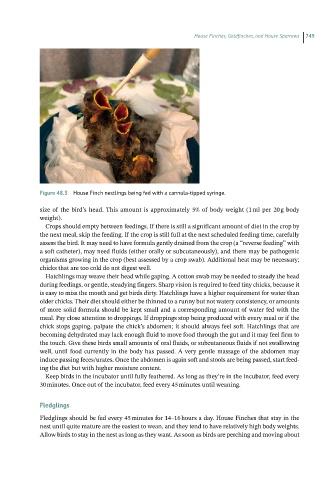Page 747 - Hand rearing birds second
P. 747
House Finches, Goldfinches, and House Sparrows 749
Figure 48.3 House Finch nestlings being fed with a cannula-tipped syringe.
size of the bird’s head. This amount is approximately 5% of body weight (1 ml per 20 g body
weight).
Crops should empty between feedings. If there is still a significant amount of diet in the crop by
the next meal, skip the feeding. If the crop is still full at the next scheduled feeding time, carefully
assess the bird. It may need to have formula gently drained from the crop (a “reverse feeding” with
a soft catheter), may need fluids (either orally or subcutaneously), and there may be pathogenic
organisms growing in the crop (best assessed by a crop swab). Additional heat may be necessary;
chicks that are too cold do not digest well.
Hatchlings may weave their head while gaping. A cotton swab may be needed to steady the head
during feedings, or gentle, steadying fingers. Sharp vision is required to feed tiny chicks, because it
is easy to miss the mouth and get birds dirty. Hatchlings have a higher requirement for water than
older chicks. Their diet should either be thinned to a runny but not watery consistency, or amounts
of more solid formula should be kept small and a corresponding amount of water fed with the
meal. Pay close attention to droppings. If droppings stop being produced with every meal or if the
chick stops gaping, palpate the chick’s abdomen; it should always feel soft. Hatchlings that are
becoming dehydrated may lack enough fluid to move food through the gut and it may feel firm to
the touch. Give these birds small amounts of oral fluids, or subcutaneous fluids if not swallowing
well, until food currently in the body has passed. A very gentle massage of the abdomen may
induce passing feces/urates. Once the abdomen is again soft and stools are being passed, start feed-
ing the diet but with higher moisture content.
Keep birds in the incubator until fully feathered. As long as they’re in the incubator, feed every
30 minutes. Once out of the incubator, feed every 45 minutes until weaning.
Fledglings
Fledglings should be fed every 45 minutes for 14–16 hours a day. House Finches that stay in the
nest until quite mature are the easiest to wean, and they tend to have relatively high body weights.
Allow birds to stay in the nest as long as they want. As soon as birds are perching and moving about

